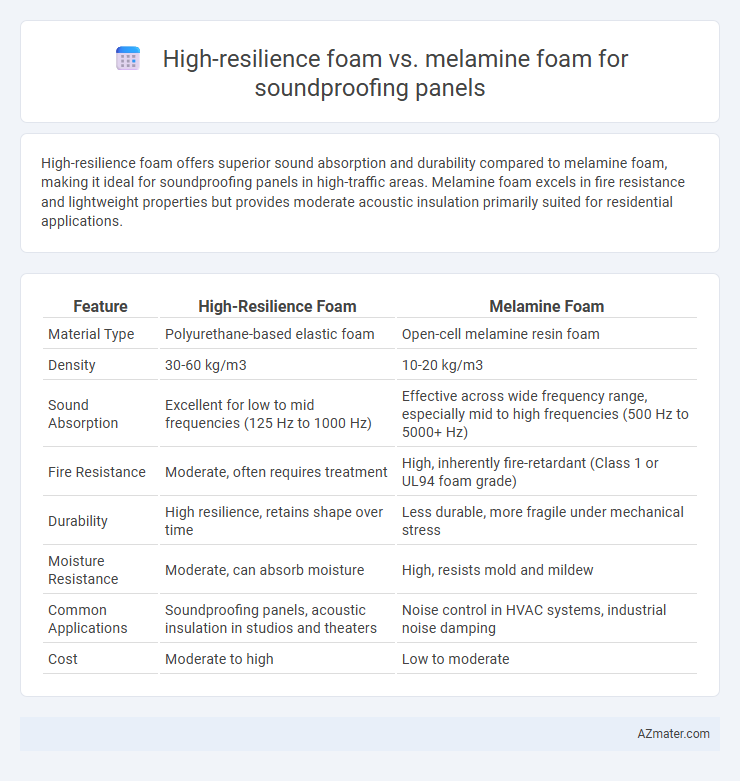High-resilience foam offers superior sound absorption and durability compared to melamine foam, making it ideal for soundproofing panels in high-traffic areas. Melamine foam excels in fire resistance and lightweight properties but provides moderate acoustic insulation primarily suited for residential applications.
Table of Comparison
| Feature | High-Resilience Foam | Melamine Foam |
|---|---|---|
| Material Type | Polyurethane-based elastic foam | Open-cell melamine resin foam |
| Density | 30-60 kg/m3 | 10-20 kg/m3 |
| Sound Absorption | Excellent for low to mid frequencies (125 Hz to 1000 Hz) | Effective across wide frequency range, especially mid to high frequencies (500 Hz to 5000+ Hz) |
| Fire Resistance | Moderate, often requires treatment | High, inherently fire-retardant (Class 1 or UL94 foam grade) |
| Durability | High resilience, retains shape over time | Less durable, more fragile under mechanical stress |
| Moisture Resistance | Moderate, can absorb moisture | High, resists mold and mildew |
| Common Applications | Soundproofing panels, acoustic insulation in studios and theaters | Noise control in HVAC systems, industrial noise damping |
| Cost | Moderate to high | Low to moderate |
Introduction to Soundproofing Panels
Soundproofing panels utilize materials like high-resilience foam and melamine foam to effectively reduce noise transmission. High-resilience foam offers excellent sound absorption through its dense, elastic structure, making it ideal for controlling mid to low frequencies. Melamine foam stands out for its lightweight, open-cell composition, providing superior performance in absorbing higher frequency sounds and improving overall acoustic comfort.
What is High-Resilience Foam?
High-resilience foam is a highly durable and flexible material with excellent sound absorption properties, commonly used in soundproofing panels for its ability to reduce noise through efficient energy absorption and minimal deformation over time. It features an open-cell structure that allows sound waves to penetrate and dissipate, improving acoustic performance in environments requiring noise control. In comparison, melamine foam offers superior fire resistance and lighter weight but generally provides less durability and resilience under continuous pressure.
What is Melamine Foam?
Melamine foam is a lightweight, open-cell material known for its excellent sound absorption and thermal insulation properties, making it ideal for soundproofing panels. Its unique structure allows it to effectively trap sound waves, reducing noise and echo within indoor environments. Compared to high-resilience foam, melamine foam offers superior fire resistance and durability, enhancing safety and longevity in acoustic treatments.
Acoustic Performance Comparison
High-resilience foam offers superior sound absorption with an NRC (Noise Reduction Coefficient) typically ranging from 0.85 to 0.95, effectively reducing mid to high-frequency noise. Melamine foam, known for its open-cell structure, provides excellent soundproofing in the 250 Hz to 4000 Hz range with an NRC around 0.80, making it ideal for thermal insulation combined with acoustic treatment. While high-resilience foam excels in durability and impact resistance, melamine foam is lighter and more fire-resistant, influencing the choice based on specific acoustic and safety requirements.
Durability and Longevity
High-resilience foam offers superior durability and longevity compared to melamine foam, maintaining its shape and soundproofing properties over extended periods under varying environmental conditions. Melamine foam, while effective in sound absorption due to its open-cell structure, tends to deteriorate faster and is more susceptible to compression and environmental damage. For long-term soundproofing applications, high-resilience foam provides a more reliable and robust solution.
Fire Resistance and Safety
High-resilience foam offers moderate fire resistance but can release toxic fumes when exposed to high temperatures, posing safety concerns in soundproofing applications. Melamine foam excels in fire resistance with its inherent flame-retardant properties and low smoke emission, making it a safer choice for acoustic panels in environments requiring stringent fire safety standards. Choosing melamine foam enhances both fire safety and sound absorption performance, crucial for residential and commercial soundproofing solutions.
Installation and Handling
High-resilience foam offers excellent durability and flexibility, making it easier to cut and shape during installation without losing its structural integrity. Melamine foam is lightweight and fire-resistant but tends to be more brittle, requiring careful handling to avoid crumbling or damage. Both materials provide effective sound absorption; however, high-resilience foam typically allows quicker, more forgiving application on uneven surfaces due to its resilient properties.
Cost-Effectiveness
High-resilience foam offers superior durability and long-term sound absorption, making it a cost-effective choice for soundproofing panels in environments with frequent use or heavy wear. Melamine foam has a lower initial cost and provides excellent fire resistance and acoustic performance for less demanding applications, but may degrade faster over time. Evaluating total lifecycle costs--including maintenance and replacement--high-resilience foam typically delivers greater value for high-traffic or commercial installations.
Environmental Impact
High-resilience foam exhibits lower environmental impact due to its durability and longer lifespan, reducing waste and frequency of replacement in soundproofing panels. Melamine foam, derived from synthetic materials, often has higher embodied energy and limited recyclability, leading to increased environmental burden. Choosing high-resilience foam supports sustainable soundproofing solutions through enhanced energy efficiency and reduced landfill contributions.
Choosing the Right Foam for Soundproofing
High-resilience foam offers superior durability and excellent sound absorption, making it ideal for long-term soundproofing panels with high impact resistance and energy return. Melamine foam excels in thermal insulation and acoustic absorption for mid- to high-frequency noise, often used in environments requiring fire resistance and lightweight materials. Selecting the right foam depends on factors like frequency range of noise, fire safety regulations, and installation durability, with high-resilience foam favored for heavy-duty applications and melamine foam preferred for fire-retardant, lightweight soundproofing solutions.

Infographic: High-resilience foam vs Melamine foam for Soundproofing panel
 azmater.com
azmater.com